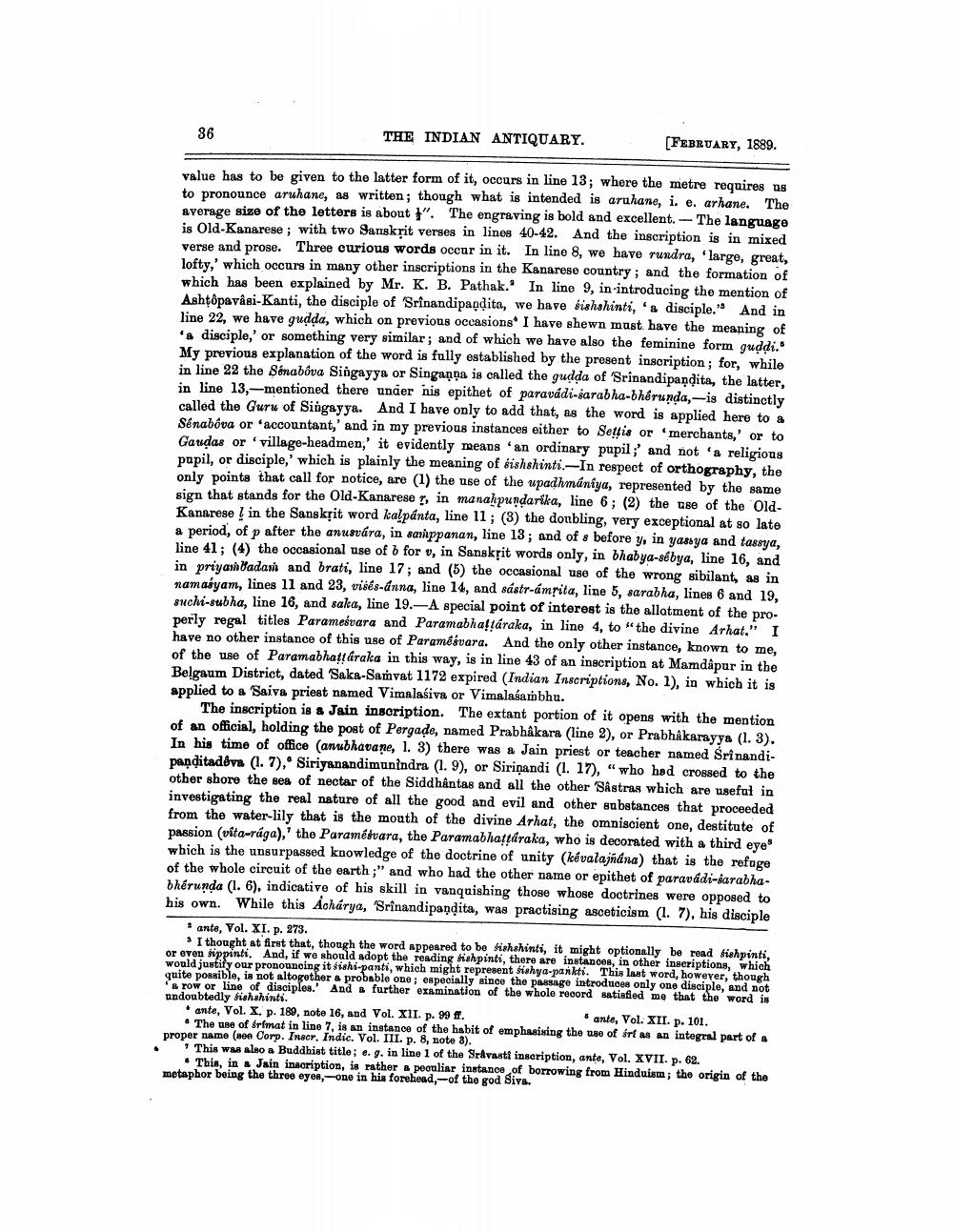________________
36
THE INDIAN ANTIQUARY.
[FEBRUARY, 1889.
value has to be given to the latter form of it, occurs in line 13; where the metre requires us to pronounce aruhane, as written; though what is intended is aruhane, i. e. arhane. The average size of the letters is about 1". The engraving is bold and excellent. -The language is Old-Kanarese; with two Sanskrit verses in lines 40-42. And the inscription is in mixed verse and prose. Three curious words occur in it. In line 8, we have rundra, large, great, lofty,' which occurs in many other inscriptions in the Kanarese country, and the formation of which has been explained by Mr. K. B. Pathak.' In line 9, in-introducing the mention of Ashtôpavisi-Kanti, the disciple of Srinandipandita, we have bishshinti, a disciple." And in line 22, we have gudda, which on previous occasions I have shewn must have the meaning of a disciple,' or something very similar; and of which we have also the feminine form guddi. My previous explanation of the word is fully established by the present inscription; for, while in line 22 the Sónabőva Singayya or Singanna is called the gudda of Srinandipandita, the latter, in line 13,-mentioned there unaer nis epithet of paravádi-sarabha-bhérunda, -is distinctly called the Guru of Singayya. And I have only to add that, as the word is applied here to a Sénabova or 'accountant,' and in my previous instances either to Settis or merchants,' or to Gaudas or village-headmen,' it evidently means an ordinary pupil;' and not a religious pupil, or disciple,' which is plainly the meaning of bishshinti.-In respect of orthography, the only points that call for notice, are (1) the use of the upadhmániya, represented by the same sign that stands for the Old-Kanarese, in manahpundarika, line 6; (2) the use of the OldKanarese l in the Sanskrit word kalpánta, line 11; (3) the doubling, very exceptional at so late a period, of p after the anusvára, in sarppanan, line 13; and of before y, in yasaya and tassya, line 41; (4) the occasional use of b for v, in Sanskpit words only, in bhabya-sébya, line 16, and in priyanada and brati, line 17; and (5) the occasional use of the wrong sibilant, as in namasyam, lines 11 and 23, visés-ánna, line 14, and sástr-ámsita, line 5, sarabha, lines 6 and 19, suchi-subha, line 16, and saka, line 19.-A special point of interest is the allatment of the properly regal titles Paramešvara and Paramabhaltáraka, in line 4, to "the divine Arhat." I have no other instance of this use of Paraméśvara. And the only other instance, known to me, of the use of Paramabhattáraka in this way, is in line 43 of an inscription at Mamdapur in the Belgaum District, dated Saka-Samvat 1172 expired (Indian Inscriptions, No. 1), in which it is applied to a Saiva priest named Vimalaśiva or Vimalasambhu.
The inscription is a Jain inscription. The extant portion of it opens with the mention of an official, holding the post of Pergade, named Prabhâkara (line 2), or Prabhakarayya (1.3). In his time of office (anubhavane, 1. 3) there was a Jain priest or teacher named Srinandipaņditadeva (1.7), Siriyanandimunindra (1.9), or Sirişandi (1. 17), “who had crossed to the other shore the sea of nectar of the Siddhantas and all the other Såstras which are useful in investigating the real nature of all the good and evil and other substances that proceeded from the water-lily that is the mouth of the divine Arhat, the omniscient one, destitute of passion (vita-rága),' the Paramédvara, the Paramabhattáraka, who is decorated with a third eye which is the unsurpassed knowledge of the doctrine of unity (kévalajñana) that is the refuge of the whole circuit of the earth ;" and who had the other name or epithet of paravádi-sarabhabhérunda (1. 6), indicative of his skill in vanquishing those whose doctrines were opposed to his own. While this Acharya, 'Srînandipandita, was practising asceticism (1.77), his disciple
• ante, Vol. XI. p. 273.
> I thought at first that, though the word appeared to be fishshinti, it might optionally be read fishpinti, Or even sippinti. And, if we should adopt the reading fish pinti, there are instances, in other inseriptions, which would justify our pronouncing it fishi-panti, which might represent sishya-pankti. This last word, however, though quite possible, is not altogether a probable one; especially since the passage introduces only one disciple, and not
row or line of disciples. And further examination of the whole record satisfied me that the word is undoubtedly fishshinti. • ante, Vol. X. p. 189, note 16, and Vol. XII. p. 99 ff.
ante, Vol. XII. p. 101. • The use of Srimat in line 7, is an instance of the habit of emphasining the use of irf as an integral part of a proper name (nee Corp. Inecr. Indic. Vol. III. p. 8, note 8).
This was also a Buddhist title; e. g. in line 1 of the Srdvaati inscription, ante, Vol. XVII. p. 62.
• This, in Jain inscription, is rather peopliar instance of borrowing from Hinduism; the origin of the metaphor being the three eyes, one in his forehead, -of the god Sivs.




